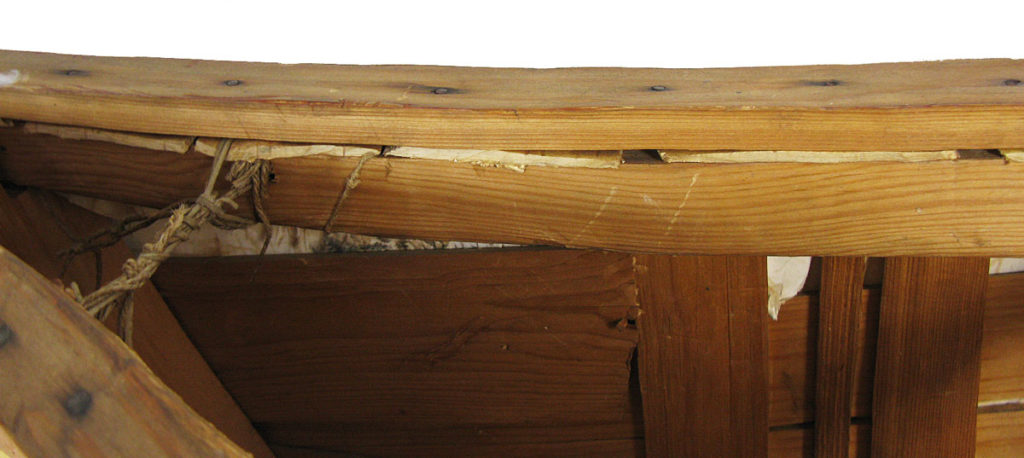Cree Birch Bark Canoe
As the summer season unfolds, fortunate vacationers and cottage owners will have the opportunity to spend peaceful hours on the water paddling canoes. It is thus a fitting time to remember and celebrate Native-made birch bark canoes, the progenitor of recreational canoes made of wood and canvas, aluminum, or high-tech plastic that most of us use today.
This birch bark canoe (now sold) is a traditional Eastern Cree hunter’s canoe that we obtained in Quebec where it was made in the 1920s.
Eastern Cree territory
Eastern Cree homelands run along the east coast of lower Hudson Bay and James Bay, and inland southeastward from James Bay (for perspective, the Eastern Cree community of Wemindji is 820 miles northwest of Montreal).
Thanks to the scholar Edwin Tappan Adney and his colleague Howard I. Chapelle whose book The Bark Canoes and Skin Boats of North America (Smithsonian Institution, 1964) documented the detailed characteristics of many different tribes’ canoes, it is possible to match this canoe’s attributes to those of Eastern Cree designs.
Illustration of Cree canoe details by Adney & Chapelle.
This canoe is petite at only 12’ long (by 32” wide and 15” high). Adney and Chapelle describe this model as a straight-bottom Cree hunter’s canoe that is lightweight and a sized to hold one paddler plus gear.
This barely (possibly never) used canoe came from the Montreal area, so it was most likely purchased by an affluent sportsman after a fishing expedition led by a Cree guide in the greater James Bay region.
Early photo of Eastern Cree guides with canoe (Adney & Chapelle)
Canoes could be transported between James Bay and Montreal via railway beginning in the early 1900s—and still can be (we have used that service ourselves).
The canoe’s bark has an appealingly aged, amber patina. As per tradition, the inner bark of the birch tree was used for the exterior of the canoe, while the less waterproof, flakey exterior birch tree bark was turned to the inside of the canoe, scraped to make it smoother, and then covered with planking and ribs.
Stretching out a roll of birch bark to begin canoe building. (Adney & Chapelle)
Most of the body of the canoe is a single piece of birch bark, but the sides have additional panels that were added to attain necessary width.
A page from Adney & Chapelle showing how birch bark was cut and gores and panels inserted.
The cuts that were made to shape the bark were then overlapped and sewn together with spruce root.
Those seams, as well as the seams joining the side panels to the rest of the bark, were then sealed.
The seams of this canoe are sealed with real pitch (not tar, which was sometimes used as a sealant for later canoes) that would have been heated and mixed with wood ash or charcoal and deer fat to repel water.
Strips of sinew lashing join the bark to the stems.
Cloth impregnated with pitch is tacked over the portion of the stems that ride in or close to the water to reinforce the waterproofing.
The birch bark sides are rolled over the top of the inwale, then a cap rail was added on top and nailed down to the inwale.
The cedar ribs, gunwales and planks of this canoe are hand riven rather than sawn.
The narrow, v-shaped cedar boards inserted into the bow and stern are called headboards. They close off and brace the hull in the area beyond the ribs.
Finally, thick, native-tanned moose hide straps are lashed to the center thwart to hold paddles during portaging, and another piece of hide tied to two thwarts was probably used as a painter to secure the boat to a tree at a landing.
The Canoe’s Decorative Value
Although this canoe is probably still water tight, or could be made so with a few touches of pitch sealant, its best use now is as a decorative object. It is really hard to find an antique birch bark canoe that is such a perfect size for displaying on a wall or from rafters.
Hanging canoes as décor in rustic lodges goes way back to the turn-of-the-20th-century rusticator era. This circa 1900 photo of an Adirondack lodge interior shows a birch bark canoe displayed on a wall, with taxidermy bear heads above and plaques of Native American silhouettes below it.
We expect that our canoe’s days of traversing waterways are over, but hopefully it will continue to be admired for its looks, as well as for the important role that birch bark canoes played in the evolutionary history of watercraft.




































